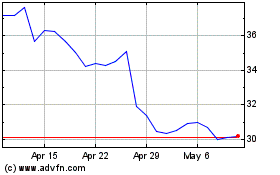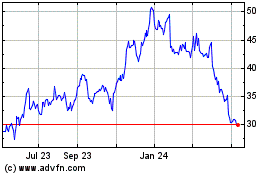Intel Profits Slide Amid PC Slump--3rd Update
October 13 2015 - 6:44PM
Dow Jones News
By Don Clark and Tess Stynes
Intel Corp. revealed more pain from the shrinking personal
computer business in the latest quarter, but higher chip prices and
demand for larger computers helped soften effects of the slump.
The company on Tuesday said third-quarter profits fell 6.3% from
the year-earlier period on a slight revenue decline. Intel, whose
results were slightly higher than analysts expected, issued a
forecast for the fourth quarter that was in line with Wall Street
estimates.
Intel, the biggest supplier of chips that serve as calculating
engines in computers, gets most of its revenues from chips for PCs.
That business has been struggling because of factors that include a
shift in consumer spending to smartphones.
Market trackers International Data Corp. and Gartner Inc. last
week reported sharp declines in shipments, countering hopes that
the release of Microsoft Corp.'s new Windows 10 operating system
might spur demand.
Analysts said buyers had put off purchases until the arrival of
PCs built with Skylake, a long-awaited overhaul of Intel's flagship
Core line of microprocessors. Intel said it benefited in the third
period as the company shipped those chips to PC makers.
"Despite ongoing macroeconomic headwinds, there are signs that
the PC market is beginning to stabilize," said Brian Krzanich,
Intel's chief executive, during a conference call with
analysts.
Intel's new Core models command higher prices than earlier
products, helping to offset weaker unit shipments. Intel said
Tuesday that shipments of chips used in desktop computers fell 15%,
while notebook chip volumes were down 14%. But revenue for what
Intel calls its client computing unit declined only 7%.
Besides higher prices, Intel said that cutting back on subsidies
for sales of chips used in tablet-style computers helped boost
revenues.
Meanwhile, sales of chips for the server systems that run most
corporate back-office operations rose 12%. Those microprocessors
command higher selling prices and wider profit margins than PC
chips.
"As we move forward, the server division is clearly going to
become more important to profitability," said Bill Kreher, an
analyst at Edward Jones.
The company said revenues for the division devoted to the
Internet of Things--a term reflecting chips for just about
everything but computers--increased nearly 10% to $581 million.
In all, the Santa Clara, Calif., company reported third-quarter
net income of $3.11 billion, or 64 cents a share, down from profit
in the year-earlier period of $3.32 billion, or 66 cents a share.
Revenue declined to $14.47 billion from $14.55 billion.
Intel's closely watched gross profit margin declined to 63% from
65%.
Analysts polled by Thomson Reuters expected per-share profit of
59 cents and revenue of $14.22 billion. The semiconductor giant in
July projected revenue of $14.3 billion, plus or minus $500
million.
For the current fourth quarter, the company estimated revenue of
$14.8 billion, plus or minus $500 million. Analysts polled by
Thomson Reuters expected revenue of $14.83 billion. Intel projected
a gross margin of 62%.
Intel's shares, up 1.8% over the past year, initially edged up
in after-hours trading following the announcement but later dropped
3%.
Stacy Rasgon, an analyst at Sanford C. Bernstein, attributed the
stock decline to concerns that Intel's server chip sales may not
grow as quickly as expected in the fourth quarter and that pricing
gains may not be sustained.
Write to Don Clark at don.clark@wsj.com and Tess Stynes at
tess.stynes@wsj.com
Subscribe to WSJ: http://online.wsj.com?mod=djnwires
(END) Dow Jones Newswires
October 13, 2015 18:29 ET (22:29 GMT)
Copyright (c) 2015 Dow Jones & Company, Inc.
Intel (NASDAQ:INTC)
Historical Stock Chart
From Mar 2024 to Apr 2024

Intel (NASDAQ:INTC)
Historical Stock Chart
From Apr 2023 to Apr 2024
